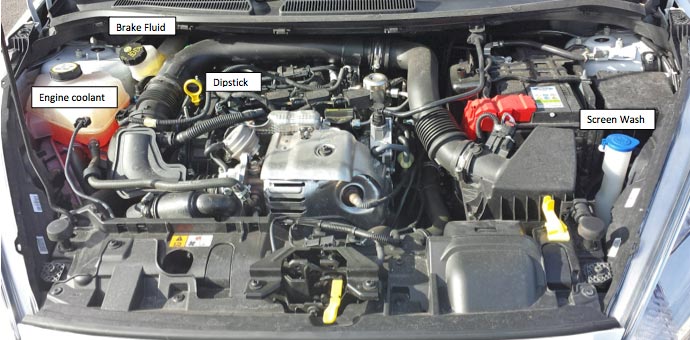Example Show me Tell me questions from the driving test exam
Failure on one or both of the show me tell me questions will result in one minor fault.

Click on the Questions to get the answer
A.: Identify the coolant tank and check the min/max markings. If the coolant is below the min mark then more coolant will need to be added. To do this, unscrew the cap and pour in coolant until the max mark is reached.
A.: Identify the brake fluid reservoir and check the fluid level against the min/max levels.
A.: If the steering becomes heavy the steering may be faulty. Before starting a journey two simple checks can be made:
1) Gentle pressure on the steering wheel, maintained whilst the engine is started, should result in slight but noticeable movement as the system begins to operate.
2) Turning the steering wheel after just moving off will give an immediate indication that the power assisted steering is functioning correctly.
1) Gentle pressure on the steering wheel, maintained whilst the engine is started, should result in slight but noticeable movement as the system begins to operate.
2) Turning the steering wheel after just moving off will give an immediate indication that the power assisted steering is functioning correctly.
A.: Activate the brake pedal and make use of reflections in garage doors etc to see if the brake lights come on or ask someone to help.
A.: Identify the dipstick, pull it out and check the oil level against the min/max markings.
A.: Press the horn and listen (turn on ignition if necessary).
A.: Operate brake pedal, make use of reflections in windows, garage doors, etc, or ask someone to help. (turn on ignition if necessary).
A.: As you move off check the brakes. They should not feel spongy and the car should not pull to one side.
A.: Turn on lights (turn on ignition if necessary), walk around car and check that the lights are on.
A.: Activate the indicators or hazard warning lights and walk around the car to see if all the indicators are working correctly.
A.: Information can be found using the car manufacturer's manual. Check the tyre pressures by using a reliable pressure gauge when the tyres are cold. Don't forget the spare and remember to refit the valve caps.
A.: The tyre should have no cuts or bulges. The tread depth should be at least 1.6mm across the central 3/4s of the breadth of the tyre and around the entire outer circumference.
A.: Apply the parking brake. When it is fully applied it should secure itself.
A.: The head restraint should be adjusted so the rigid part of the head restraint is at least as high as the eye or top of the ears, and as close to the back of the head as is comfortable. N.B. Some restraints might not be adjustable.
A.: Operate control to wash and wipe windscreen (turn on ignition if necessary).
A.: Set all relevant controls including; fan, temperature, air direction / source and heated screen to clear windscreen and windows. Engine does not have to be started for this demonstration.
A.: Warning light should illuminate if there is a fault with the anti lock braking system
A.: Operate switch (turn on ignition if necessary), check with main beam warning light.
A.: Operate switch (turn on dipped headlights and ignition if necessary). Check warning light is on. Explain use.